Perception and the Role our Behavior Plays
Have you ever noticed that the perception of others doesn’t always match the intention? For example, just because someone may come across as dominant or assertive, does not necessarily mean they are trying to be controlling or aggressive. Similarly, someone who appears reserved or quiet may simply have a more introspective nature, rather than being uninterested or disengaged.
Perception plays a crucial role in how we behave and interact with others. Understanding different behavioral styles and how they are perceived can greatly improve relationships, both at work and in our personal lives. One popular tool for identifying behavioral styles is the DISC model, which categorizes individuals into four main types: Dominant, Influential, Steady, and Conscientious. Each type has its own unique strengths and weaknesses, and understanding these can help individuals adapt their own work style to better collaborate with others.
By recognizing and respecting these differences in perception, individuals can work to build stronger relationships and more effectively communicate with those around them. However, we can’t respect these differences if we don’t first have some self-awareness. Self-awareness is a key element, and the DISC model is a way for us to gain some awareness in ourselves, reflect upon it, and then use it to personally and professionally grow. By understanding our own behavioral style, strengths, and weaknesses, we can better adapt our communication and collaborate more effectively with people like us or not like us. This can involve paying attention to nonverbal cues, such as body language and tone of voice, as well as asking questions and actively listening to understand the perspectives of others.
Collaboration is another key component of the DISC model. By working together and leveraging each other's strengths, individuals can achieve more than they would working alone. Effective collaboration requires open communication, mutual respect, and a willingness to compromise and adapt to others' needs and styles.
A favorite aspect of my job as a coach at The Quality Coach® (TQC) is to join clients on their journey of self-improvement by using assessments. This journey typically starts with a DISC behavioral style assessment and a one-on-one confidential coaching conversation with the client. This time together allows the client to learn and better understand their own behavioral style, as well as appreciate and value style diversity in the workplace and beyond. These conversations have led to some of my most rewarding experiences as a coach. Here are some of the best comments from the DISC assessment, comprehensive report, and coaching debriefs I’ve done as they are best communicated in their own words…
“I’ve reduced those exhausting thoughts of self-doubt,”
“I’m sharing my thoughts more often,”
“I’m working on listening more,”
“I’m suspending judgment and viewing others through their own eyes,”
And, one I may personally work on for the rest of my life… “patience.”
Overall, the DISC model can be a powerful tool for improving self-awareness, communication, and collaboration. By recognizing and respecting different behavioral styles, individuals can build stronger relationships and achieve greater success in both their personal and professional lives. I feel fortunate to have been introduced to DISC behavioral styles early in my life and career. It has helped me grow my self-awareness, and adapt my behavior for better outcomes as a co-worker, coach, facilitator, friend, and parent. It has proved valuable in my professional and personal life. I often remind myself and others that DISC is valuable anytime people are involved. Every single day, I see opportunities to continue the journey.
Amy Eagan

